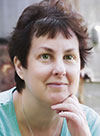Big Green Pocketbook

Listening for Stories
Each morning, when I can, I walk two and a half miles. I walk for exercise because I write most of the day. But mainly I walk to listen for stories.

Crafting a Home of the Heart
It had been years since I last visited the home of my heart, the only place where I can breathe freely. Conicville is in Shenandoah County in the Valley of Virginia, bordered by the Allegheny Mountains. It consists of a church, a cemetery, and a scattering of houses and farms. In 2012, I traveled to meet my 98-year-old cousin. His farm

The Cottage of Lost Play
Working on my magical realism middle-grade novel, I realized I couldn’t visualize where my story is located. I could describe immediate buildings, but the landscape was blank. If I couldn’t see it, neither could a reader.

Finding Wonder
When fairy tale characters step into the woods, they are beset by tests, yet are stronger by the time they find their way out. At the beginning of 2021, I wandered in a deep, dark woods because, as Bruno Bettelheim warns in The Uses of Enchantment, it’s where you go after losing the framework which gives structure to your life.

Losing Wonder
I hadn’t written in months. Yet each morning, during that misty period between sleep and wakefulness, ideas popped into my mind. In the cold winter light, though, those ideas were revealed as withered and drab. Covid stole more than concentration and motivation. It robbed me of wonder.

Making Peace with January
This year, Hal Borland’s Book of Days migrates upstairs with me to read during my afternoon rest and before bed. It’s a daily journal beginning January 1, written from his farm in rural Connecticut, meant to help him answer the questions: Who am I? Where am I? What time is it? At 68, I ask those questions, too. Borland’s entries mix mid-70s science with New England lore, his natural observations of the seasons with his own quiet musings.
January 6: Frost flowers fascinate me. They are related to frost ferns, those intricate patterns that formed on windowpanes before we slept in heated bedrooms. Frost ferns were indoor plants, created by the humidity in the room. Frost flowers are wildlings, outdoor grows created by humidity in the starlight.

Magic Needs Humble Soap
When I was ten, I wanted to be a detective-veterinarian-artist-writer-ballet dancer. Never mind I couldn’t stay up late, stand the sight of blood, or ever had a single dance lesson. Ten-year-olds view the world as limitless. When I was a teenager, my dreams shifted to more specific: a writer of children’s books and an animator for Walt Disney Studios.

Jane Langton Gave Me Geese
In Wildness is the preservation of the World. ~ Henry David Thoreau It’s rare a children’s book changes you when you’re an adult. I don’t mean fleeting Harry Potter/Team Edward crossover fandom, but genuine change (as with Watership Down). I was nearly 30 when Jane Langton’s book The Fledgling was published in 1980. At that stage of my

Big Green Textbook
My first inkling there was a thing called children’s literature came at a yard sale. I picked up a thick green textbook, Children’s Literature in the Elementary School, by Charlotte S. Huck. I marveled at the idea that people discussed and studied the books I loved and planned to write, that children’s books were literature, like Moby Dick. I was eighteen, one

Porch School
As a kid, I couldn’t wait until the first day of school — a fresh beginning, when the heat and green of summer make way for red plaid bookbags and corduroy jumpers.

Fillyjonk in Moominland
I’m trying hard not to be a Fillyjonk. Honestly, I am. Mrs. Fillyjonk is a character in Tove Jansson’s wonderful Moomintroll series. Fretful Mrs. Fillyjonk needs order in her world. If anything is out of place, or goes wrong, she is flattened by depression and anxiety. Is anything more out of order than the world we live in

Forgotten Treasures:
Scholastic Book Club Editions
The only “real” books we had in our house was a small selection of adult novels from the Doubleday Book Club. Mid-century titles such as Panther’s Moon, Lost Horizon, and Wake of the Red Witch piqued my eight-year-old interest until I opened them, dismayed by the tiny print and lackluster dialog. I had a shelf of Golden Books which

Growing a Nonfiction Reader
and Even a Nonfiction Writer
It is more important to pave the way for the child to want to know than to put him on a diet of facts he is not ready to assimilate. —Rachel Carson One would never guess from the following excerpts that a certain nine-year-old would grow up to write more than 50 nonfiction children’s books. This is from

The Crack in the Door:
How I Came to Write Bones in the White House
I’ve been keen on dinosaurs and Ice Age mammals my whole life, since I read Roy Chapman Andrews’ All About Dinosaurs. When I was nine, I added paleontologist to my string of future occupations (writer, artist, ballet dancer, detective). My love for Jefferson began when we moved to Fredericksburg in 1996. I was touring James Monroe’s Law Office downtown

Arnold Lobel at Home
Every winter I find myself missing Arnold Lobel, a quietly brilliant author-illustrator who left us far too early. I pull out my Lobel I Can Read collection. Frog and Toad Are Friends was published in 1970, the year I graduated from high school, bent on my own career in children’s books. Hailed an instant classic by many far-seeing individuals, Frog
